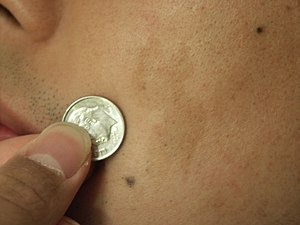Cafe-au-lait spot
| Café au lait spot | |
|---|---|
 |
|
| A café au lait spot on a patient's left cheek. | |
| Classification and external resources | |
| Specialty | dermatology |
| ICD-10 | L81.3 |
| ICD-9-CM | 709.09 |
| OMIM | 114030 |
| DiseasesDB | 16118 |
| eMedicine | ped/2754 |
| MeSH | D019080 |
Café au lait spots or café au lait macules are flat, pigmented birthmarks. The name café au lait is French for "coffee with milk" and refers to their light-brown color. They are also called "giraffe spots" or "coast of Maine spots".
They are caused by a collection of pigment-producing melanocytes in the epidermis of the skin.
These spots are typically permanent, and may grow or increase in number over time.
Café au lait spots are often harmless, but may be associated with syndromes such as neurofibromatosis type 1 and McCune–Albright syndrome.
Café au lait spots can arise from diverse and unrelated causes:
Diagnosis is visual with measurement of spot size. The number of spots can have clinical significance for diagnosis of associated disorders such as Neurofibromatosis type I. Greater than or equal to 6 spots of at least 5mm in diameter in pre-pubertal children and at least 15mm in post-pubertal individuals is one of the major diagnostic criteria for NF1.
Café au lait spots are usually present at birth, permanent, and may grow in size or increase in number over time.
Cafe au lait spots are themselves benign and do not cause any illness or problems. However, they may be associated with syndromes such as Neurofibromatosis Type 1 and McCune-Albright syndrome.
The size and shape of the spots do not have any meaning or implications with regards to diagnosis of associated syndromes.
Café au lait spots can be removed with lasers. Results are variable as the spots are often not completely removed or can come back after treatment. Often, a test spot is treated first to help predict the likelihood of treatment success.
...
Wikipedia
